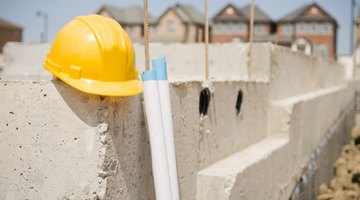Can a House Built on a Foundation Be Moved?
If you've got the perfect house on a not-so-perfect lot, moving the home to a new location often costs less than building a new house from the ground up. Regardless of foundation type, any house can be moved if there's a relatively clear path between the old lot and the new one.

Types of Foundations
Builders construct homes on one of three basic types of foundation systems. Some use footings and concrete stem walls, while others use a similar system to accommodate a basement or crawlspace below the home. Some older homes may incorporate stone foundations rather than concrete, though they support the house in much the same way. Other homes are built on a slab foundation, with footers along the corners or edges for added support. All three common home foundations allow for a house to be moved, though the movers rely on slightly different techniques to get the house ready for its journey.
How It's Done
If a home is built on stem walls, including homes built over a basement or crawlspace, moving teams start by sliding steel beams below the lower level of the home to support the structure. To make room for these beams, crews dig channels out of the earth beneath the home. If the home is constructed on a slab foundation, moving teams must carve tunnels out of the concrete slab to accommodate these beams. Once the steel beams are in place, they serve as a temporary foundation of sorts until the house reaches its new location. Movers use hydraulic jacks to lift the beams, bringing the house along for the ride. To separate the house from the foundations, movers cut through the anchor bolts or other fasteners joining the bottom of the wall framing and the top of the footer or foundation.The temporary steel beams are transported onto dollies, then sent along to the new location. Once the house is on its new land, it's placed onto a new foundation and the steel beams are removed.
Counting Costs
MSN Real Estate estimates that moving a house costs about 60 to 70 percent of the cost of building a new house, not including the cost of the land. Many different factors impact the price of a move, including the size and design of the house, the location and the path the movers must travel. Keep in mind that moving a house may involve other costs as well, including the costs of permits in the new location and along the route of travel. Some municipalities require you to bring a house up to code as if it were new when you move it to the area, which could increase your budget. Finally, consider the cost of a new foundation and landscaping for the relocated home.
Beware of Obstacles
While virtually every structurally sound home can be moved successfully, external obstacles can get in the way and make a move difficult or impossible. Consider the path that the home must take from its existing location to the new one; any trees, power lines, traffic signals or overhead lines might spell the end for a move. While some of these items can be trimmed, relocated or temporarily moved, the cost of doing so may be prohibitive. Narrow, winding roads or weight limits on area bridges could also stop a house move before it begins. In some cases, moving companies may be able to separate sections of a house and move them separately to avoid obstacles. For example, removing the attic from the top of a home may allow it to fit beneath power lines and other obstacles along your route.
The Drip Cap
- If you've got the perfect house on a not-so-perfect lot, moving the home to a new location often costs less than building a new house from the ground up.
- Some use footings and concrete stem walls, while others use a similar system to accommodate a basement or crawlspace below the home.
- If a home is built on stem walls, including homes built over a basement or crawlspace, moving teams start by sliding steel beams below the lower level of the home to support the structure.
- Keep in mind that moving a house may involve other costs as well, including the costs of permits in the new location and along the route of travel.
- While virtually every structurally sound home can be moved successfully, external obstacles can get in the way and make a move difficult or impossible.
- Consider the path that the home must take from its existing location to the new one; any trees, power lines, traffic signals or overhead lines might spell the end for a move.
References
Resources
Writer Bio
Emily Beach works in the commercial construction industry in Maryland. She received her LEED accreditation from the U.S. Green Building Council in 2008 and is in the process of working towards an Architectural Hardware Consultant certification from the Door and Hardware Institute. She received a bachelor's degree in economics and management from Goucher College in Towson, Maryland.
Photo Credits
- Stacey Newman/iStock/Getty Images
- Stacey Newman/iStock/Getty Images
More Articles



